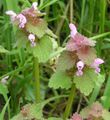Lamium purpureum
| Red dead-nettle | |
|---|---|

| |
| Scientific classification | |
| Kingdom: | Plantae |
| Clade: | Tracheophytes |
| Clade: | Angiosperms |
| Clade: | Eudicots |
| Clade: | Asterids |
| Order: | Lamiales |
| Family: | Lamiaceae |
| Genus: | Lamium |
| Species: | L. purpureum
|
| Binomial name | |
| Lamium purpureum | |
Lamium purpureum, known as red dead-nettle,[1] purple dead-nettle, or purple archangel,[2] is an annual herbaceous flowering plant native to Europe and Asia.
Varieties:
- Lamium purpureum var. hybridum (Vill.) Vill. (synonym: Lamium hybridum Vill.)[3]
Description
Lamium purpureum grows with square stems to 5–20 cm [4](rarely 30 cm) in height. The leaves have fine hairs, are green at the bottom and shade to purplish at the top; they are 2–4 cm long and broad, with a 1–2 cm petiole (leaf stalk), and wavy to serrated margins.
The zygomorphic flowers are bright red-purple, with a top hood-like petal, two lower lip petal lobes and minute fang-like lobes between. The corolla shows a line of hairs near the base of the tube.[4] They may be produced throughout the year, including mild weather in winter. This allows bees to gather its nectar for food when few other nectar sources are available. It is also a prominent source of pollen for bees in March/April (in UK), when bees need the pollen as protein to build up their nest.
It is often found alongside Henbit Dead-nettle (Lamium amplexicaule), which is easily mistaken for it since they both have similar looking leaves and similar bright purple flowers; they can be distinguished by the stalked leaves of Red Dead-nettle on the flower stem, compared to the unstalked leaves of Henbit Dead-nettle.[4]
Though superficially similar to species of Urtica (true nettles) in appearance, it is not related and does not sting, hence the name "dead-nettle".
Uses
Young plants have edible tops and leaves, used in salads or in stir-fry as a spring vegetable. If finely chopped it can also be used in sauces.[5]
Undyed, the pollen itself is a red colour and is very noticeable on the heads of bees that frequent its flowers.[citation needed]
Folk herbalists use purple dead nettle in many herbal remedies. One of these is purple dead nettle salve that can be used on irritated, itchy, or sore skin.[6]
Habitat
Frequent in meadows, forest edges, roadsides and gardens.[4]
Distribution
Lamium purpureum is a common weed in the western and eastern United States,[7] Canada, Ireland, and the British Isles.[8]
Biochemistry
The essential oil is characterized by its high contents of germacrene D.[9] The seed oil contains 16% of an acid characterized as (−)-octadeca-5,6-trans-16-trienoic acid (trivial name `lamenallenic acid'). Other unsaturated esters identified by their cleavage products are oleate, linoleate and linolenate.[10]
The plant contains phenylethanoid glycosides named lamiusides A, B, C, D and E.[11] It possesses a flavonol 3-O-glucoside-6″-O-malonyltransferase.[12]
Gallery
-
Lamium purpureum, Flora von Deutschland, Österreich und der Schweiz 1885
-
L. purpureum in Valley View, Ohio, United States.
-
Leaf
-
Field of L. purpureum in Ohio, United States.
References
- ^ BSBI List 2007 (xls). Botanical Society of Britain and Ireland. Archived from the original (xls) on 2015-06-26. Retrieved 2014-10-17.
- ^ Martin, W. Keble, 1965. The Concise British Flora in Colour. George Rainbird Limited.
- ^ "Lamium hybridum Vill. | Plants of the World Online | Kew Science". Plants of the World Online. Retrieved 14 February 2021.
- ^ a b c d Parnell, J. and Curtis, T. 2012. Webb's An Irish Flora. Cork University Press. ISBN 978-185918-4783
- ^ "Purple Deadnettle: Pictures, Flowers, Leaves & Identification | Lamium purpureum". www.ediblewildfood.com. Retrieved 2021-04-17.
- ^ "Wildcrafting Purple Dead Nettle For Food And Medicine". www.outdoorapothecary.com. 23 March 2021. Retrieved 2021-03-23.
- ^ Whitson, Tom (2000). Weeds of the West. Newark, CA: Western Society of Weed Science in cooperation with the Western United States Land Grant Universities Cooperative Extension Services. ISBN 9780788149269.
- ^ Clapham, A.R., Tutin, T.G. and Warburg, E.F. 1968. Excursion Flora of the British Isles. Cambridge University Press. ISBN 0-521-04656-4
- ^ Flamini, G.; Cioni, P. L.; Morelli, I. (2005). "Composition of the essential oils and in vivo emission of volatiles of four Lamium species from Italy: L. Purpureum, L. Hybridum, L. Bifidum and L. Amplexicaule". Food Chemistry. 91: 63–68. doi:10.1016/j.foodchem.2004.05.047.
- ^ Mikolajczak, KL; Rogers, MF; Smith Cr, Jun; Wolff, IA (1967). "An octadecatrienoic acid from Lamium purpureum L. Seed oil containing 5,6-allenic and trans-16-olefinic unsaturation". Biochemical Journal. 105 (3): 1245–1249. doi:10.1042/bj1051245. PMC 1198447. PMID 16742552.
- ^ Ito, N.; Nihei, T.; Kakuda, R.; Yaoita, Y.; Kikuchi, M. (2006). "Five new phenylethanoid glycosides from the whole plants of Lamium purpureum L". Chemical & Pharmaceutical Bulletin. 54 (12): 1705–1708. doi:10.1248/cpb.54.1705. PMID 17139106.
- ^ Suzuki, H. (2004). "CDNA cloning and functional characterization of flavonol 3-O-glucoside-6"-O-malonyltransferases from flowers of Verbena hybrida and Lamium purpureum". Journal of Molecular Catalysis B: Enzymatic. 28 (2–3): 87–93. doi:10.1016/j.molcatb.2004.01.005.
External links
 Media related to Lamium purpureum at Wikimedia Commons
Media related to Lamium purpureum at Wikimedia Commons- Jepson Manual Treatment
- USDA Plants Profile
- Photo gallery
- Botanical Society of Britain and Ireland information for Lamium purpureum L. Archived 2020-12-05 at the Wayback Machine







